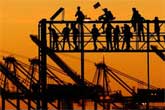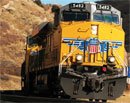| |
|
| |
|
 |
Supply
Chain by the Numbers |
| |
|
| |
- Feb. 5, 2015 -
|
| |
|
| |
|
| |
|
| |
Countdown to West Coast Port Lockout; Rapid Growth in Factory Robot Adoption in China; Union Pacific Profits Continue to Roll Along; Logistics Costs in China Remain Very High |
| |
|
| |
| |
| |
5 |

|
|
|
| |
| |
|
61.4%
|
 |
The incredible operating ratio, or operating expense divided by operating revenue, a key metric in the transport sector, that Union Pacific was able to achieve in Q4, a record for itself and the industry. That led UP to see net income as a percent of sales of a robust 23.3%, a number that would stand up very well against almost every sector. Procter & Gamble's net income as a percent of revenue in Q4 was 11.8%, for example. Other rail carriers had reasonably strong ORs as well, with CSX at 71.8%, Norfolk Southern at 69%, and Kansas City Southern at 66.7%. Having now reached its goal of a full year OR of 64%, UP has set a new target to achieve an OR of just 60% by 2019.
|
| |
| |
|
| |
| |
18% |
|
That's the percent that logistic costs typically represent versus sales for shipping and moving goods in China, according to the latest edition of the MIT Center for Transportation and Logistics' Supply Chain Frontiers newsletter. That of course is much, much higher than in developed economies, and it is a bit ironic that China - known for such efficiency and low costs in manufacturing goods - has such an inefficient internal logistics system that supports that manufacturing. Intercity toll charges amount to a high percentage of those overall overall transportation costs, MIT reports. But it also notes foreign 3PLs are starting to enter the Chinese market in a big way, which may change this picture through more efficient operations, especially in greater use of technology, which Chinese 3PLs to date have been reluctant to adopt. MIT says deregulation of the 3PL sector in China is also occuring, which may help end the very siloed nature of most 3PL service offerings today there. |
| |
| |
|
|
|
| |
 |
 |
| |
|
|
| |